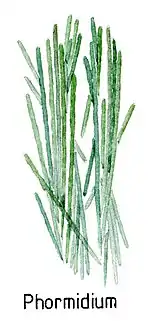Phormidium
Phormidium ist eine Gattung fädiger Cyanobakterien, oder „Blaualgen“. Typspezies der Gattung ist Phormidium lucidum Kützing ex Gomont.[1] Die Gattung bildet toxische Sekundärmetabolite[2].
| Phormidium | ||||||||||||
|---|---|---|---|---|---|---|---|---|---|---|---|---|

Eine Phormidium-Kolonie in La Réunion | ||||||||||||
| Systematik | ||||||||||||
| ||||||||||||
| Wissenschaftlicher Name | ||||||||||||
| Phormidium | ||||||||||||
| Kützing ex Gomont, 1892 |

Illustration
Merkmale
Phormidium wächst in Matten aus langen, unverzweigten Zellfäden (Filamenten). Diese sind von einer dünnen, farblosen Gallerthülle umgeben[3]. Einzelzellen sind von blaugrüner bis violetter Farbe[1]. Zur Vermehrung werden Hormogonien gebildet.
Arten (Auswahl)
- Phormidium corium
- Phormidium formosum
- Phormidium lucidum
- Phormidium subfuscum
Einzelnachweise
- AlgaeBase: Phormidium Kützing ex Gomont, 1892
- I. Teneva, B. Dzhambazov, L. Koleva, R. Mladenov, K. Schirmer: Toxic potential of five freshwater Phormidium species (Cyanoprokaryota). In: Toxicon, Band 45, Nr. 6, Mai 2005, S. 711–725, PMID 15804520, doi:10.1016/j.toxicon.2005.01.018.
- D. M. John, Brian A. Whitton, Alan J. Brook: The freshwater algal flora of the British Isles: an identification guide to freshwater and terrestrial algae, Band 1. Cambridge University Press (England) 2002.
Weblinks
Commons: Phormidium – Sammlung von Bildern, Videos und Audiodateien
This article is issued from Wikipedia. The text is licensed under Creative Commons - Attribution - Sharealike. The authors of the article are listed here. Additional terms may apply for the media files, click on images to show image meta data.